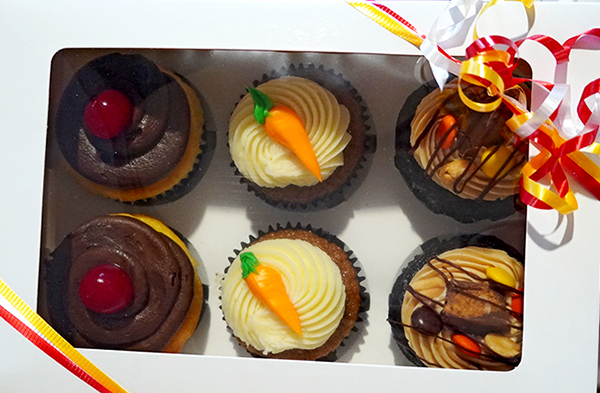Lawn party for an eclipse
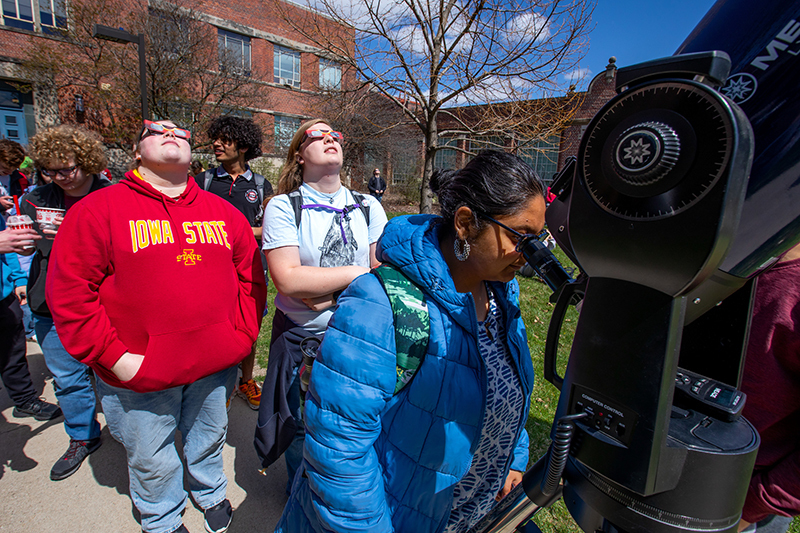
Graduate student Punya Aragula, human-computer interaction, views the solar eclipse through a telescope fitted with an optical solar filter Monday afternoon. Seniors Kristy Parker (left) and Blake Stumpf wait for their turn. Photos by Christopher Gannon.
It turns out a solar eclipse -- even a partial one -- does wonders for community building. Two hundred or so people gathered on the small lawn west of Physics Hall Monday afternoon to experience the moon's eclipse of the sun, one of many such lawns around campus. Nearly all of them packed their smartphones; less than half arrived with eclipse-viewing safety glasses. No matter.
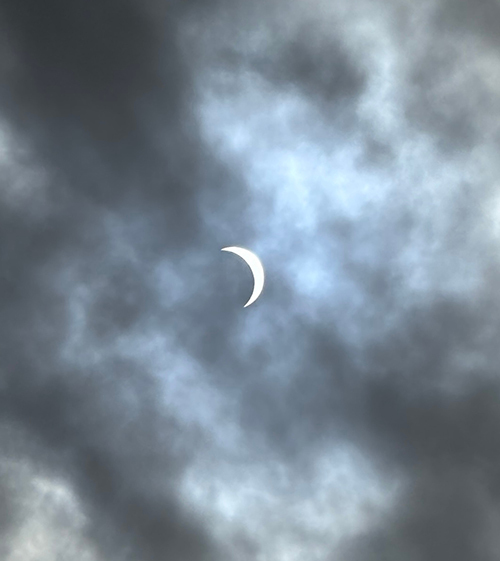
They generously passed around their cardboard glasses and scanned websites on their phones for helpful details to share about what they were marveling at. There even were a few kitchen colanders among the group, used to capture crescent-shaped shadows on the pavement.
Associate professor of astronomy Charles Kerton moved two telescopes outside for eclipse views other than the naked eye: the photosphere (or sun surface) and the chromosphere, a thin plasma layer visible only during a solar eclipse. Both lie inside the corona gas layer. Iowa Staters patiently waited in lines never shorter than 20 people to view the eclipse and try to capture that image on their own smartphones.
It's not a great photo, Kerton said, but about 80% took a photo through the telescope's eyepiece.
A few overheard comments (many conversations weren't in English):
- "That's nuts!"
- "It's awesome."
- "It's almost better in the cloud cover."
- "Holy S*3t!!!"
- "We're so lucky we're in the Goldilocks zone. We have everything."
- "Europe gets the next one in a year and a half."
- "Ohhhhhhhhh. Ohhhhhhhhh!!"
- "That looks so cool."
- "That was worth waiting in line."
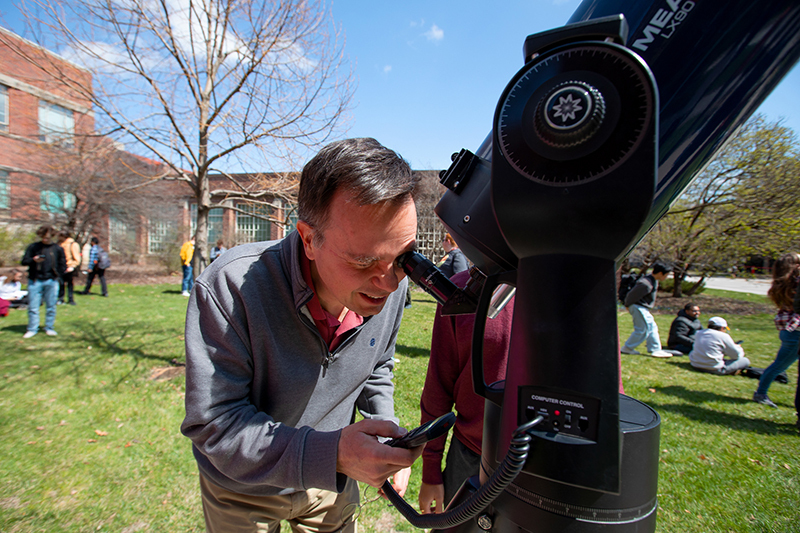
Associate professor of astronomy Charles Kerton adjusts the site on one of two telescopes he moved outdoors Monday for solar eclipse viewing.
Provost candidate visits begin next week
Campus visits this month are confirmed for four finalists for Iowa State's senior vice president and provost leadership post. The first candidate arrives Monday. The visit dates for the four candidates are:
- Candidate 1, April 15-16
- Candidate 2, April 17-18
- Candidate 3, April 22-23
- Candidate 4, April 29-30
The name and curriculum vitae for each finalist will be shared on the administrative searches website the day preceding their visit.
Campus forums
Each candidate will meet with members of the university community during their two-day visit and participate in a campus forum at 3 p.m. on the first day. The forum schedule is:
- Candidate 1, April 15, Alliant Energy-Lee Liu Auditorium, Howe Hall
- Candidate 2, April 17, Sun Room, Memorial Union
- Candidate 3, April 22, Sun Room, Memorial Union
- Candidate 4, April 29, Alliant Energy-Lee Liu Auditorium, Howe Hall
For those who cannot attend in person, the forums will be recorded and made available on the search page after all the finalist visits are completed.
Everyone participating in a campus forum is encouraged to complete an online candidate feedback form for that candidate.
Vice president for economic development and industry relations and dean of the Ivy College of Business David Spalding is leading the 18-member search committee, assisted by Parker Executive Search firm. Senior vice president and provost Jonathan Wickert announced in January plans to return to the faculty in the department of mechanical engineering this summer.
Related stories:
- Search begins for next senior vice president and provost, Jan. 25, 2024
- Wickert announces move to faculty this summer, Jan. 18, 2024
Senators approve term faculty changes
Meeting April 9, the Faculty Senate approved changes to the Faculty Handbook on term faculty members' ability to hold administrative roles, periodic reviews, and reviews for renewal and advancement. The changes are:
- Term faculty members' ability to hold administrative roles is determined at the department and college level.
- One unsatisfactory annual review automatically triggers a peer review.
- Assistant professor term faculty must have a peer review before the end of their third year and subsequent reviews every three years.
- Associate professor and professor term faculty must be reviewed at least every seven years.
- Term research faculty and adjunct faculty up for advancement with at least 50% research in their position responsibility statement must include up to three external letters as part of the review process.
- Term faculty at the lecturer or assistant rank must serve five years at the university to advance to associate. Credit for prior faculty service at other academic institutions can be applied for advancement before term faculty sign their first multiyear contract.
Prior to voting on these changes, senators also adopted two amendments. The first adds language to clarify why peer reviews of performance are important:
- "This peer review protects term faculty academic freedom by ensuring that disciplinary experts make judgments of quality of performance in areas of position responsibility."
The second notes each college or department can determine when and how peer reviews are used.
Newton discusses policing at ISU
Associate vice president of public safety and chief of police Michael Newton addressed policing at the university with senators. He summarized the mission and makeup of the department of public safety (DPS), and talked about training officers receive to avoid the use of force whenever possible.
He said he strives for the department to be as transparent as possible, noting that a daily online dashboard lists all calls for service and arrests.
"We provide daily data through dashboards. There are monthly reports, there is a running five-year report that is available, and quarterly we report on our use of force," he said. "Over 50% of our cases have nothing to do with our students. They are other people who come to campus and have things happen and cause issues."
Newton leads the DPS which includes the ISU police department, risk management, parking, DPS emergency management, building security services and key management. The last two functions were added to DPS from facility planning and management in November to bring more safety functions under one department.
Police calls and use of force
Newton addressed the use of force as part of police calls. "We do not use force very often and because of that we scrutinize those a lot more," he said.
In 2023, ISU police received 33,815 calls for service that led to 736 arrests. Of those, 12 (1.63%) involved the use of force. In 2022, 10 uses of force were used during 742 arrests.
Newton explained the department's four-part review process following a complaint when force is used. A use of force is considered anything above compliant handcuffing.
- The officer's supervisor does an immediate review and submits a report to the chief of police.
- A captain does a full assessment, including reviewing video footage and talking with the officer. Those with the complaint may be interviewed if necessary.
- The assistant chief does a review of all findings.
- The findings are sent to the chief of police.
"Sometimes I concur and sometimes I don't," Newton said. "I may ask them to look at other pieces and I will look at training components that could address trends we are seeing."
Training
Newton said the department does extensive training on de-escalation and the use of force. Each year a training plan is developed with a different training on a range of subjects highlighted each month. Some trainings are required by law and others by the state Board of Regents.
"We are working toward national accreditation for the department and meeting the gold standard for police departments across the country," he said. "We also are preparing to go through a communications training that is a national best practice that puts officers through scenarios that require them to use de-escalation tactics to be successful."
Newton also recently created a new position -- captain of professional standards and training -- that will oversee accreditation, review all cases where force is used, handle citizen complaints and review department training when hiring is complete.
Other business
- Senators approved a certificate in health care management from the management and entrepreneurship department. The 20-credit certificate is designed to help students transition from clinical to managerial roles where balancing finances, assessing programs and leading are important. The certificate would be available to all undergraduate students.
- Senators will vote at the next meeting on changes to the Faculty Handbook's section on college governance documents. Each college's budget advisory council or committee meets and advises the dean, so the council or committee must include the college's senate representative on the resource policies and allocations council in addition to faculty from multiple departments.
Surprise! Museums' visual literacy uses a scientific process
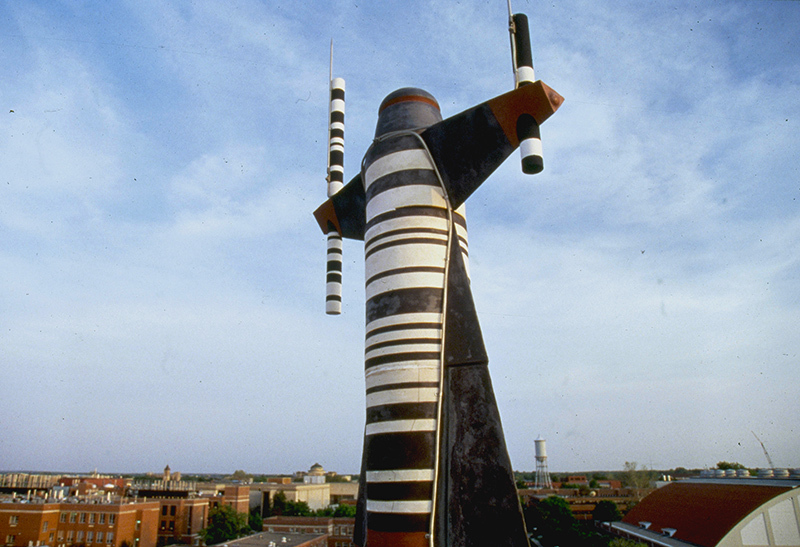
One of artist Andrew Leicester's G-Nome sculptures atop Molecular Biology Building, part of Iowa State's Art on Campus collection. Submitted image.
Learners can apply the scientific method -- collect data, interpret and finally evaluate the information -- to unfamiliar images the same way they do words or numbers. That's the premise for the visual literacy program at university museums.
"It's exactly what scientists do, it's their process," said director Lynette Pohlman. "We use a different vocabulary in visual literacy, but it's the same process: You hold off on your evaluation until you better understand what you're looking at."
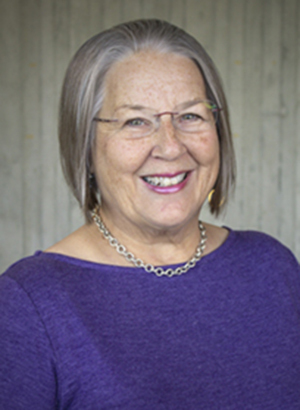
Pohlman
And because university museums' primary purpose is not to curate art exhibitions, but to support the university's mission of educating students, Pohlman said her staff wants to reach more students by working with more faculty to integrate visual literacy into a class session. Seven museum staff members and eight trained docents are available to lead visual literacy discussions, a question-answer process to collect data. The program is free for campus.
Faculty liaison for visual literacy
Classroom instructors have access to the 30,000-plus works of art in the museums' collections -- paintings, sculptures, textiles, glass, pottery, prints and more -- to build their students' critical thinking and communication skills. More than 2,500 of those works of art, the Art on Campus collection, are in indoor and outdoor public spaces. Depending on faculty's selections, some art also may test students' understanding of concepts in their academic discipline.

Gallus
For example, professor of geological and atmospheric sciences Bill Gallus understandably is drawn to paintings with a weather story to tell.
"Art is a really good vehicle for getting our students to think deeply about a subject matter and doing it in a way where they take the time to collect the data and interpret it, before they jump to some conclusion," Gallus said. "Visual literacy is not about whether they like a piece or not."
"You have to beware of any 'edutainment' expectations among students," he added. "I use it to make them really think -- or to reinforce something they've learned about the subject matter."
Gallus has a one-year appointment as a faculty affiliate with the Center for Excellence in Learning and Teaching, focused on expanding visual literacy in the STEM fields. University museums received a 2024 grant through the 2022-31 strategic plan's competitive proposal process to fund the part-time position.
His assignment is to encourage faculty to weave visual literacy into their instruction.
"Once you've created a class, I know it's difficult to choose something to remove to make time for this," Gallus said. "Visual literacy really is another take on the scientific process, and it's worth trying to work it into your syllabus."
Give it a try
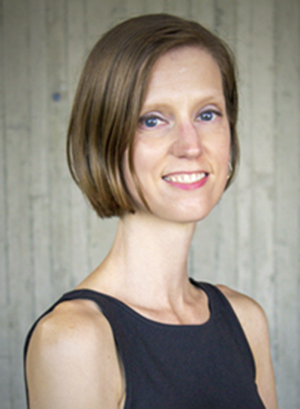
Gennett
The best thing about those 30,000 works of art in the university museums collection? Faculty don't have to review them all to select what they'd like to share in their class. Contact the museum staff, tell them what you're teaching and what you're interested in to supplement it.
"We can integrate our collections into your curriculum in about any way you could imagine," said Adrienne Gennett, curator of the Brunnier Art Museum who coordinates visual literacy efforts and works with faculty to learn how visual literacy can fit into post-pandemic learning methods. "We're quick to say yes, and then we figure it out. We try to make access as easy as possible."
To help narrow the selection process for STEM faculty, she and Gallus created object packages -- folders of art recommendations for courses in the life sciences or physical sciences. Find them among other packages on the museums' collections database.
Visual literacy sessions could look like:
- Indoor tour of a current exhibition or public art site
- Outdoor tour of selected public sculptures
- Set of objects pulled from the collection (in-person or online)
- Extra-credit assignment in one of the galleries
- Student assignment: Attend a scheduled museums program
Pohlman said her team frequently uses the nine Grant Wood panels in a Parks Library staircase, "When Tillage Begins Other Arts Will Follow" to introduce visual literacy.
"It's accessible, it tells a narrative, contains history, it's less daunting and has some commonality with us -- as opposed to abstract art, which makes us think and feel harder," she said.
Several other large, public works of art have been used successfully and broadly in visual literacy sessions across academic disciplines: G-Nomes by Andrew Leicester atop the Molecular Biology Building, Floating World by Ralph Helmick in the Biorenewables Complex atrium, and "Breaking the Prairie Sod," also by Grant Wood, in Parks Library.
Growing a community of visual literacy advocates
Nearly as old as university museums -- which celebrates 50 years this fall -- visual literacy at Iowa State had its start in 1976 when museums staff partnered with the former College of Education to train both student teachers and museums docents on understanding and learning to talk about art. Earlier that year, Pohlman observed visual literacy in action at the Boston Children's Museum.
University Museums collections
- Anderson Sculpture Garden, south and east of Morrill Hall
- Art on Campus collection: public art in buildings and outside
- Brunnier Art Museum, Scheman Building
- Christian Petersen Art Museum, Morrill Hall
- Farm House Museum, a period house (time focus of 1860-1910)
But Iowa's Art in State Buildings legislation (1979-2017) gave it flight. The law required one-half of 1% of the budget for state construction projects be reserved for fine arts in the building. On this campus, that legislation added 183 public works of art to the Art on Campus collection. Just as important, it drew more than 1,700 faculty, staff and students into the public art process, one committee at a time.
"Art on campus is a democratic process. The museums' role is to provide a professional pool of public artists, but the people on the committees make the decisions," Pohlman said. "By the time they commission a public work of art, they have visual literacy under their belts."
She recalled an early project, the east addition to Agronomy Hall in the early 1980s. Department chair John Pesek put all 26 of his (male) faculty members on the public art committee, and the discussion evolved from bronzing a tractor to commissioning a bronze sculpture, Janus Agri Altar, by female artist Beverly Pepper for the Agronomy courtyard.
"For the next 10 years, we had more agronomy students in the museum than any other department. The faculty got it, and they incorporated what they learned," Pohlman recalled. "It was a powerful lesson for us at the museum."
In spring 2000, a class project by a museums student intern proved pivotal in reaching large numbers of freshmen and sophomores consistently. The intern surveyed English 150 instructors about their awareness of university museums and understanding of visual literacy. She sold them on the concept of using museum tours and visual literacy to strengthen the writing process, and suddenly museums staff were doing about 90 tours per semester for introductory writing students.
By 2019, Pohlman said museums staff and docents were reaching 43 to 63 university departments each year. Who those were often trailed the public art commissions -- or was influenced by senior faculty who were visual literacy advocates and had some latitude to tweak course curricula to create space for it.
And then came 2020. Among its many impacts, the COVID pandemic sent instruction online and brought a hard stop to in-person tours and classroom visual literacy discussions. Numerous regular faculty users of the visual literacy program retired. Pohlman said the restart has involved new strategies -- such as Gallus' position -- and collaborations with a new set of faculty instructors.
Strategic plan funds extend impact of open educational resources
The use of open educational resources (OER) has expanded significantly across the university in the last five years, but the need remains for program- and course-specific options. University Library dean Hilary Seo and staff used a $300,000 initial strategic plan award to add to Iowa State's free and affordable instruction materials.
Need OER help?
Instructors interested in using or learning more about open educational resources can contact Abbey Elder.
OER range from textbooks to lesson plans and videos. They are openly licensed, allowing instructors to adapt and edit them to their course needs. At Iowa State, the use of OER has saved students $2.5 million since 2018.
Last spring, the library team issued two calls for strategic plan fund proposals, one to fund projects developing infrastructure to support the use of affordable course materials ($75,000), a second for course content ($225,000). The team awarded funds to four infrastructure projects and four content projects. Open access and scholarly communication librarian Abbey Elder said the content projects focus on undergraduate high-enrollment courses and courses in subject areas where OER options are minimal.
"We have seen a huge increase in awareness, interest and use of OER on and off campus," Elder said. "More faculty are coming to me to talk about OER in disciplines I wasn't necessarily thinking about. Apparel design and architecture are fields where the need is there for more niche and high-level OER because that is where there aren't as many commercial books available to meet the demand."
Elder said more than 40 instructors currently use OER in their courses to eliminate or reduce the cost of materials for students. OER remain essential in the immediate access program to keep course materials costs low for all students and eliminate barriers of access to course materials.
Here is an update on a couple of the grant projects underway:
Content projects
A group from the Graduate College, with partners in the library and the Office of Research Ethics, is building a modular research handbook covering key areas of the research process for students. The handbook designers are constructing chapters on the research process and, in some cases, modifying other OER material to their needs. Elder said the proposal may seem basic -- it is one handbook -- but its impact could be significant at ISU and other institutions across the nation.
"It can be adapted for high-level undergraduate courses and graduate courses," she said. "Because it's modular, it's beneficial to so many disciplines, and that makes it very useful."
Elder said the project fills a gap between Library 160, a freshman introduction to college-level research, and more intensive research in upper level and graduate courses.
"It helps them build on the baseline of how to do research, to how to do research in a particular field without having to rely on someone else to show them," she said.
Faculty will be able to use the handbook as a guide in courses or with student research assistants, eliminating the need to cover research basics so faculty can delve into more in-depth topics.
Another project focuses on developing OER across courses in the agronomy core sequence, which would nearly eliminate materials costs for the degree program. Elder said it started as an idea for a few agronomy courses and spread as more instructors learned about its development.
"It's an incredibly high-impact project that may inform others across campus," she said.
Infrastructure projects
A team with members from the library, information technology services, financial aid, admissions, institutional research and the ISU Book Store currently is testing a data dashboard of course material costs across Iowa State. The intent is to share information with students that helps them anticipate the costs of their degree. The dashboard will provide the percentage of zero- and low-cost textbooks across the university and allow students to get a rough estimate of course materials costs within a specific course or program. Information is from the past year -- not the current semester.
"We have conversations about how we can be more transparent about the costs of textbooks at Iowa State," Elder said. "The university does a great job helping students search for and find their current textbook information, but highlighting the courses that have low- or no-cost textbooks is a good way to show students and parents how Iowa State faculty are working hard to keep costs down."
The bigger picture for affordable course materials
OER is just one part of the library's effort to keep course materials affordable.
"OER is one of the areas in our three-pronged approach to keep materials costs low for students, along with course reserves and support of expert librarians," said University Library communications manager Melea Licht. "Librarians help instructors identify free and low-cost resources and help connect students with those resources via library and course guides."
The library secures copyright permissions and pays costs for course reserves -- print and electronic -- when possible to provide free materials to students.
Since 2018, the library and other sponsors support the Miller Open Education Mini-Grant program to assist faculty who develop innovative classroom resources. The program awarded $31,000 in mini-grants to projects in 2023; April 15 is the deadline to submit 2024 proposals.
Nine teaching-based projects selected for Miller fellowships
Nine faculty projects received funding for the 2024-25 academic year in the Center for Excellence in Learning and Teaching's (CELT) annual Miller Fellowship program. Six of the projects relate to "Artificial Intelligence (AI) Across the Curriculum," focused on exploring and integrating generative AI into innovative teaching and learning. The nine teaching-based research projects, with representation from all eight colleges to impact student-centric instruction across the university, will share a total of $385,552 -- the most funding of any year of the program.
Who is Mr. Miller?
The Miller faculty fellowships are named for F. Wendell Miller, a Rockwell City attorney whose estate created the Miller Endowment Trust, with income from the trust divided evenly between Iowa State University and the University of Iowa. Miller was born in Altoona, Illinois, and grew up in Rockwell City. An alum of Grinnell College and Harvard Law School, he practiced law in Des Moines and Chicago before returning to Rockwell City to manage his family's farm holdings. He died in 1995 at age 97. At Iowa State, the annual earnings support faculty development proposals, graduate scholarships and other academic initiatives. The faculty fellowship program is administered by the president's office and CELT.
Since 1996, and including 2024-25, 241 Miller Fellowship projects have received nearly $4.6 million in grant funds. CELT's advisory board reviewed all submissions in January and made funding recommendations to the senior vice president and provost for final approval.
Artificial Intelligence Facilitated Literature Review
Principal investigators: Elena Cotos, Lily Compton, Sarah Huffman and Kristin Terrill, Center for Communication Excellence, Graduate College
Award: $47,689
This project addresses the need to instruct graduate students in effective, efficient and ethical preparation of literature reviews using generative AI (GenAI). The team will design an instructional module, AI-Facilitated Literature Review (AI-FLR), with materials and hands-on activities for generating summaries and critical comparisons of literature based on user-curated sets of publications and leveraging GenAI capabilities through Elicit, an add-on to a citation management tool such as Zotero. The module will offer instructions for using Elicit in the process of preparing an AI-FLR, including principles of research ethics and integrity. Project assessment will focus on instructional effectiveness and on pre/post learning outcomes from pilots in a graduate studies course and in a writing workshop provided by the Center for Communication Excellence. The outcomes will inform wider-scale implementations and additional GenAI-supported scholarly communication modules.
Critical AI in Education Pathways: A Comprehensive Resource for Instructors on Ethical AI Integration
Principal investigator: Evrim Baran, School of Education
Collaborating faculty: Denise Crawford, Kristina Tank, Ben Van Dusen and Ezequiel Aleman, School of Education; Sarah Van Dusen, music and theatre
Award: $50,000
Educators have few opportunities to engage in critical conversations about AI in education (AIed). Addressing this urgent need, this project will create an educational resource, Critical AIed Pathways, that will feature accessible and customizable online modules for instructors to facilitate conversations around the integration of AIed with future teachers based on ethical, technical, pedagogical and practical aspects of AIed. Interactive and modular learning content, along with K-12 in-service teacher video-cases, will foster a reflective approach where instructors will discuss the integration of AI in their teaching contexts. This project contributes to the broader field of education by offering a valuable resource for the School of Education community and beyond.
Fostering Economic Literacy Among Principles of Macroeconomics Students
Principal investigators: Oleksandr (Alex) Zhylyevskyy, Amani Elobeid and Miyoung Oh, economics
Award: $49,984
Economic literacy is the ability to apply economic principles and logic to make informed decisions about economic encounters in daily life. Acquiring it is crucial for undergraduates who will face increasingly complex choices at every stage of adult life, from paying off student loans to saving for retirement. Research shows that undergraduates know surprisingly little about economics, suggesting that “traditional” economics courses miss the opportunity to effect improvement. We will employ novel pedagogical techniques developed by economics education experts to redesign two sections of Principles of Macroeconomics to focus on economic literacy. They will be taught with two traditional course sections in the same semester. We will deploy a standardized, validated test of economic literacy to gather data on pre- and post-course literacy levels in all sections and apply a difference-in-differences econometric method to infer whether literacy targeting has a positive differential effect.
ISUComm Foundation Courses Redesign Institute
Principal investigators: Lesley Bartlett, Amy Walton and Brenna Dixon, English
Award: $49,200
At the ISUComm Foundation Courses Redesign Institute, teams of faculty will collaboratively revise the curriculum for ENGL 150, 250 and 250H in light of current technological advances such as ChatGPT. Informed by writing studies research and scholarship, this project will update the foundation courses curriculum to continue to support all ISU undergraduate students in their development as thinkers and writers.
Large Language Models and Computer Algebra Systems in Calculus Courses
Principal investigators: Claus Kadelka and Heather Bolles, mathematics
Collaborating faculty: Paul Barloon, Joseph Iverson, Elijah Stines, Dane Mayhook and Jue Yan, mathematics; Cris Schwartz, mechanical engineering
Award: $43,984
We will develop curriculum focused on AI platforms that use large language models (e.g. ChatGPT) and computer algebra systems (e.g. WolframAlpha) for deployment in the calculus sequence (MATH 165, 166, 265 and 266/267). The curriculum will introduce students to using these tools to solve computational and narrative oriented problems. Students will explore the capabilities -- and the shortcomings -- of these tools in the context of calculus problems that typically are solved by hand. Our curriculum will build skills in the use of AI tools and enhance learning of calculus concepts through the evaluation of the tools’ output. We will pilot our curriculum in several small-enrollment sections during the fall 2024 semester and deploy it across all sections during the spring 2025 semester.
Paws and Prints: A Groundbreaking Collaboration for Cutting-Edge, 3D-Printed Veterinary Teaching Models
Principal investigator: Anne Jablinski, veterinary diagnostic and production animal medicine
Collaborating faculty: Kim Moss, art and visual culture; Aliye Karabulut-Ilgu and Mandy Fales-Williams, veterinary pathology
Award: $37,940
Hepatic disease, which manifests grossly in many textures, colors and distributions, serves as an excellent body system to teach complex aspects of pathology and the pathogenesis of disease. To enhance the understanding and learning of hepatic disease among veterinary students with both visual and tactile tools, we will use 3D printing to create models that mimic hepatic tissue in both the normal and diseased state. The expected outcome is:
- Biomedical illustration students will learn the best materials to create lifelike models of hepatic tissue.
- Veterinary students in first through third year will increase competency surrounding hepatic disease through interaction with 3D models.
This project will serve as a framework for further educational work using lifelike 3D models from multiple body systems.
STEM Learning Enhancement and Development through Artificial Intelligence for Undergraduate Students in Introductory Biology Courses
Principal investigators: E.J. Bahng, School of Education; Clark Coffman, genetics, development and cell biology; Stephen Gilbert, industrial and manufacturing systems engineering; Mack Shelley, political science
Collaborating faculty: Clyde Campbell and Jelena Kraft, genetics, development and cell biology; Robert Wallace, ecology, evolution and organismal biology
Award: $50,000
An interdisciplinary faculty team, representing four colleges, will develop STEM learning enhancement and development through AI for non-STEM majors in introductory biology courses (BIOL 101). An innovative AI-empowered self-assessment feedback tool will:
- Enhance the understanding of core biology concepts (Goal 1: Enhanced content knowledge).
- Develop critical thinking skills through a retrieval practice of repeated self-testing (Goal 2: Improved metacognitive monitoring).
- Improve confidence to engage in a growing number of socio-scientific issues such as pandemics, climate change, emerging novel technologies and advances in genomic medicine (Goal 3: Engaged science-literate citizens, science literacy).
Our team, formed last summer, proposes to explore AI in Education (AIED) potentials and offer an innovative AIED curriculum intervention.
Tailored AI Tutoring for Improved Student Outcomes in Animal Science and Engineering Disciplines
Principal investigator: Karl Kerns, animal science
Collaborating faculty: Thomas Brumm, agriculture and biosystems engineering
Award: $50,000
This project introduces tailored AI tutoring for improved student outcomes in animal science and engineering disciplines, initially focusing on Domestic Animal Anatomy and Physiology lab (ANS 214L) and Fundamentals of Technology (TSM 210). The AI tutoring system will provide personalized learning experiences, and the models will be trained with course content from the two courses to formulate questions and provide feedback to students when they don't answer correctly. Recognizing diverse academic needs among students, the system also will support students in the prerequisite knowledge essential for student success, such biology, calculus and physics. During the first year, we'll develop and validate the AI tutor in these initial courses. Success in this phase will allow expansion in year two into other courses in these departments, followed by implementation across the college and university.
Using "Friday Night in the ER" to Teach System Thinking in Healthcare Management Classes
Principal investigator: Natallia Gray, management and entrepreneurship
Collaborating faculty: John Meyer, Manjot Bhussar and Robert Olinger, management and entrepreneurship
Award: $6,755
We propose integrating "Friday Night in the ER," an experiential learning game, into an existing healthcare management course in the department of management and entrepreneurship to teach system thinking. The tabletop game offers a practical approach to teaching system thinking by challenging the participants to play the role of a hospital department manager during a simulated 24-hour period, compressed into one hour. Participants will apply core principles of systems thinking to achieve excellent system-wide performance, measured by quality of care, cost and efficiency. To facilitate this learning activity, we will purchase 12 game kits to accommodate 48 players and train two faculty who will guide and enhance the educational experience for students.
A partner for producers
Editor's note: This feature is the fourth in news service's 2024 Innovation at Work series of stories, photos and videos that highlight economic development and the impact of Iowa State's contributions across the state. A new entry will post every Tuesday through April 23.
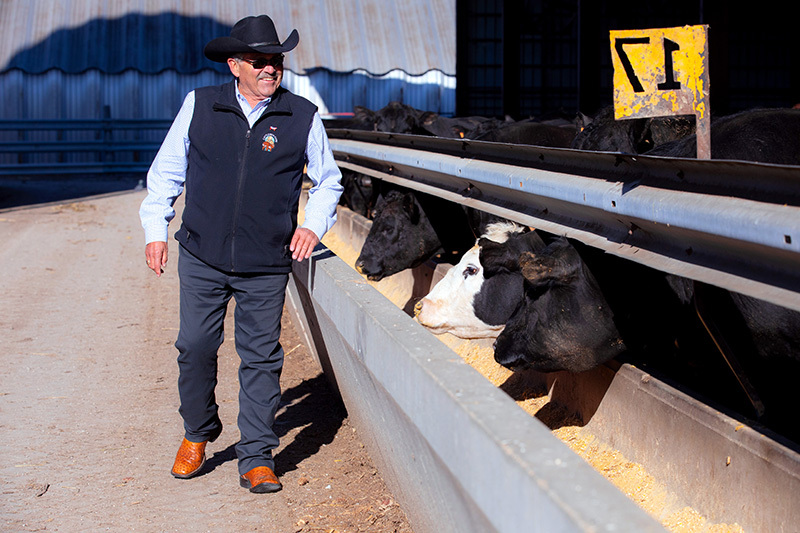
Bill Couser walks past cattle at his feedlot near Nevada. Photo by Christopher Gannon.
Mike Paustian raises hogs in eastern Iowa, where his family has farmed for six generations. At their home farm, tucked behind the Iowa 80 truck stop near Walcott, his parents still live in the house his great, great, great grandfather built.
Paustian Enterprises remains a family-run, farrow-to-finish operation. Pigs are bred, born and fed to market weight on corn they grow and mill, a crop fertilized by the hogs' manure. It's a traditional self-contained cycle of swine production, enhanced by contemporary practices such as solar power and cover crops. The Paustians are always looking for ways to improve, and Iowa State's Veterinary Diagnostic Laboratory (VDL) is indispensable in that quest.
"I can't overemphasize how important the Veterinary Diagnostic Lab is to our farm. Just as we have taken advantage of new technologies, the VDL has been doing the same thing. We've grown together, in many ways," Mike Paustian said. "If we didn't have the resources at the VDL to understand what's going on in our herd, I don't think raising pigs would be nearly as fun or profitable. We'd constantly be chasing our tails."
As the VDL enters a new era -- opening the first portion of a two-phase, $141.5 million facility designed to handle the mounting caseloads of the present and unknown challenges of the future -- fellow clients who rely on the lab echo Paustian's sentiments. The VDL's speed, expertise and devoted service make it an essential partner for livestock and poultry producers, the behind-the-scenes foundation of one of Iowa's most important industries.
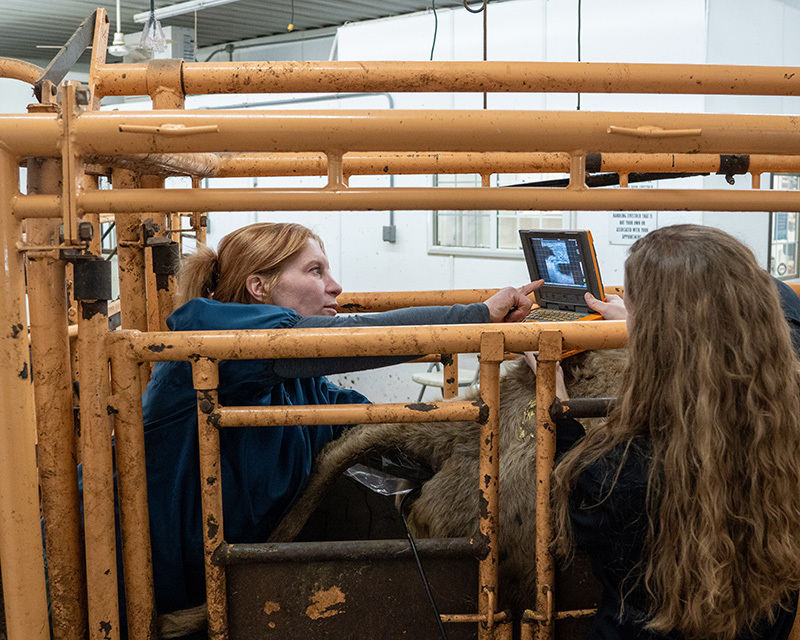
Dr. Jodie Pettit performs an ultrasound on a cow in the large-animal unit of AMVC's Audubon clinic. Photo by Sophie Hansen.
Million-dollar decisions
In her 23 years in practice at the Audubon-based AMVC Veterinary Services, Dr. Jodie Pettit has seen most of the company's expansion over three decades from a small-town veterinary clinic to one of the country's largest swine management operations. AMVC manages 45 farms across 11 states, overseeing about 163,000 sows. That dramatic transformation wouldn't have happened without the VDL, said Pettit, one of the company's 17 partners and a mixed-animal veterinarian at the original clinic in Audubon.
"It's pivotal for us. We have been able to grow at the rate we have because we have access to a world-class lab," she said. "We're making million-dollar decisions multiple times a day based on whether it's safe to move animals to, say, a large sow barn. You're risking all the animals already at the barn every time you open the door to new arrivals."
With farms across the country, AMVC has worked with numerous diagnostic labs, Pettit said. Iowa State's VDL, which handles the nation's largest food animal caseload, easily stands out as the best. Part of that is speed, a major emphasis of VDL operations. A couple of examples Pettit cited: The lab's self-built software provides clients access to test results as they come in, and certain herd monitoring tests offer same-day results.
The VDL's commitment to customer service also sets it apart, Pettit said. The lab's faculty and staff understand what's riding on their work, she said.
"Everybody is on pins and needles when we're moving animals. The truckers are waiting. The truck wash is waiting. The people unloading and loading on both ends are waiting. It's really a time crunch to get those answers back," she said. "To say the VDL is customer-oriented is a major understatement. They truly go above and beyond. If they need to, they stay late to make sure those movements are possible. They understand what we in the trenches are going through."
'They operate the way we do'
Or to put it the way Dr. Craig Rowles says it: "They run that lab like we run our businesses. This is not just an 8-5 job. They operate the way we do as producers."
Video
Iowa farmers find critical partner in Veterinary Diagnostic Lab.
Rowles started out as a large-animal veterinarian in Carroll, tending mostly to cattle and hogs. He later moved into hog production and now is in the third act of his career in animal agriculture, as director of cage free operations for Versova. The Iowa-based company manages 40 million layer hens across farms in Iowa, Ohio, Washington, Oregon and Utah.
He recalled an incident at a farm in Ohio that showed the skill and devotion of the Iowa State VDL. Versova got word that a mistake at a different company's packing plant may have exposed an entire flock of hens to an antibiotic that could leave a residue in their eggs. He made a panicked Saturday morning call to the lab's director, Dr. Rodger Main. As-soon-as-possible results on an emergency toxicology screening on a weekend was a big ask, Rowles figured.
"But Rodger said, 'Well, we can do that,'" Rowles said. Versova flew samples to Ames and by Sunday had proof their eggs were clean.
The lab was just as responsive during the recent years' highly pathogenic avian influenza outbreaks, despite surging demands, he said. Urgency is crucial because producers, veterinarians and government regulators rely on diagnoses to take action, slowing disease transmission and limiting economic implications. Minor delays can cause major impacts.
"I can't say enough about how prompt they are in the face of those challenges and how important that is," Rowles said.
Peace of mind
For Bill Couser, owner of a feedlot near Nevada with up to 5,200 beef cattle, the VDL is all about peace of mind. He trusts that with the lab nearby, he'll have access to answers if -- when, more likely -- a disease outbreak happens.
"Every livestock producer in Iowa is a partner with the diagnostic lab. It's a godsend for us all. We don't even think about it. Not that we take it for granted, but we know the work will be done. That lets you sleep easy at night," he said. "Most people have no clue what happens inside that lab or what it means. But the people who use it know the value it brings for Iowa and the world."
Couser's appreciation for the lab's importance was heightened years ago by a sudden rash of cattle deaths in his herd that turned out to be bovine respiratory syncytial virus.
"You'd watch them falling over in the pen, and your heart would just sink," he said. "Iowa State's near and dear to my heart because of how they got on top of that."
The lab has a history of scaling up to handle swelling testing needs and stepping up to solve novel problems, including its responses to porcine epidemic diarrhea, avian influenza and -- in partnership with the University of Iowa's State Hygienic Laboratory -- COVID-19. It was Iowa State researchers at the VDL, in collaboration with other state and federal agencies, who detected that a recent illness that's spread to dairy herds in six states is highly pathogenic avian influenza, the first known cases of the virus infecting cattle.
Preparation for the next challenge is always a focus. The new facility was designed with surge capacity in mind, and VDL researchers are studying high-throughput testing machines that use microfluidics to process 30,000 tests a day compared to a standard machine's 2,000.
It's a track record that inspires trust, Paustian said.
"They've shown over and over again that they can ramp up quickly to support producers in an emergency. I'm not losing any sleep over that," he said.
More data, healthier food
In fiscal year 2023, Iowa State's VDL processed more than 124,000 cases involving nearly 1.7 million individual tests. It marked the 13th consecutive year the lab's caseload has increased. The skyrocketing volume is driven more by disease prevention than identification. Improved methods for collecting and analyzing samples have led to a boom in population-wide health monitoring.
For instance, swine producers routinely submit saliva collected from a rope that pigs are provided to chew on and fluids collected from castrations, methods developed by Iowa State faculty who rely on the lab's stream of cases to conduct applied research and train students. Using surveillance testing to keep any eye on the health status of his herds allows Paustian to tweak vaccines and see emerging concerns.
"We're making more data-driven proactive decisions all the time. That gives us a lot of confidence that we'll have a stable flow of healthy pigs," he said.
More than 90% of the lab's cases come from animals being raised for food. About 75% of the overall cases are swine, which represented less than 60% of cases in 2010. At AMVC, Pettit said testing is so frequent that they have an employee whose job includes driving samples to Ames on a nearly daily basis.
Poultry operations also conduct extensive monitoring, such as regular environmental tests for salmonella required in egg-laying barns, Rowles said. That helps directly protect consumers, though in one way or another most of the lab's work is geared toward ensuring food safety and public health, he said.
"The VDL plays a role every single day in making sure the eggs, meat and dairy Iowans buy in grocery stores are the safest possible product we can provide," he said.
It's a given that livestock health surveillance will continue to grow, Paustian said. He envisions a day when the lab is analyzing automatically collected submissions, rapidly providing genetic sequencing of the entire sample.
"We're really just hitting the tip of the iceberg at this point," he said.
Building for the future
VDL faculty and staff began working in the completed portion of the lab's new facility late last month. The $75 million first phase is home to sections covering about 20% of the lab's services -- necropsy, pathology, histopathology and bacteriology -- and space for receiving, routing and preparing submitted samples. Construction begins later this month to expand the facility in a $66.5 million second phase that will house the other 80% of the lab's functions.
Faculty and staff have been packed tight in the building the lab has occupied for nearly 50 years, which is connected to the rest of the college's complex. In addition to the benefits of purposefully designed and expanded space, upgrading to a standalone structure with clear boundaries between public and private areas is a vast improvement in biosafety, Main said.
"Now we're in a building that was built to be a lab, not a lab built to be in a building," he said.
One of Pettit's favorite features of the new lab is the openness. There are numerous ways throughout the building to watch faculty and staff work, including large windows dividing public hallways from bustling private lab spaces.
"The public can walk by and look right in. With the drive to understand where food comes and how animals are raised, I think that's a huge step in the right direction to give consumers confidence in the science we're performing. I'm really excited it was built that way," she said.
Offering opportunities for observation was intentional, Main said. Putting the lab's science on display will help highlight its value, sharing with a broader audience what Iowa livestock and poultry producers already know so well.
"That will help educate the public, students and international trading partners about the really good story of Iowa and U.S. food animal agriculture and the role that modern medicine plays behind the scenes in supporting a safe and abundant food supply," he said.
Using works of art for visual literacy: A few examples
University museums staff and docents have used these three public works of art in visual literacy sessions with a variety of audiences:
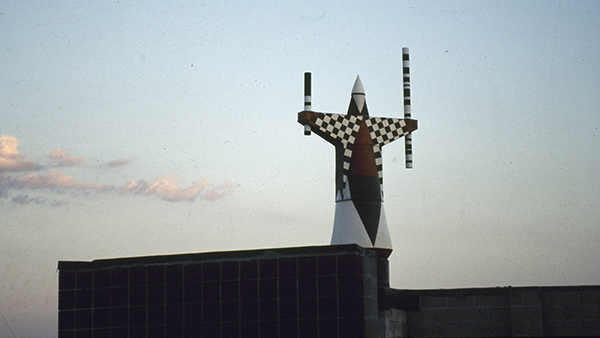
G-Nomes (four figures) (1991), by Andrew Leicester, location: roof corners of Molecular Biology Building. Submitted image.
Audiences:
|
Industrial design |
Animal science |
World languages and cultures |
Music |
|
Chemical and biological engineering |
Army ROTC |
English |
Botany |
|
Apparel, events and hospitality management |
Chemistry |
Journalism |
University Honors program |
|
Visual arts and culture |
Agronomy |
Plant pathology |
Biochemistry |
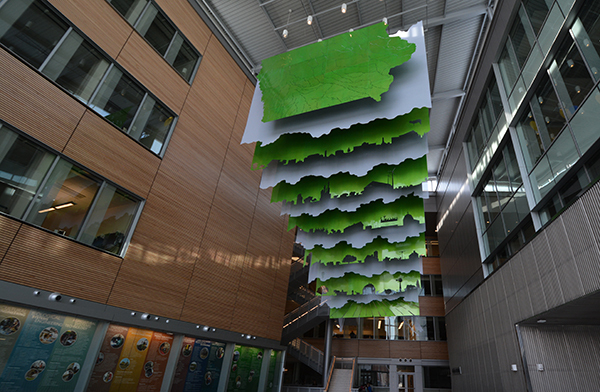
Floating World (2014), by Ralph Helmick, location: Biorenewables Complex atrium. Submitted image.
Audiences:
|
Agricultural and biosystems engineering |
Computer science |
Apparel, events and hospitality management |
English |
|
Music |
University Honors program |
Animal science |
Agronomy |
|
Journalism |
Visual arts and culture |
Industrial design |
History |
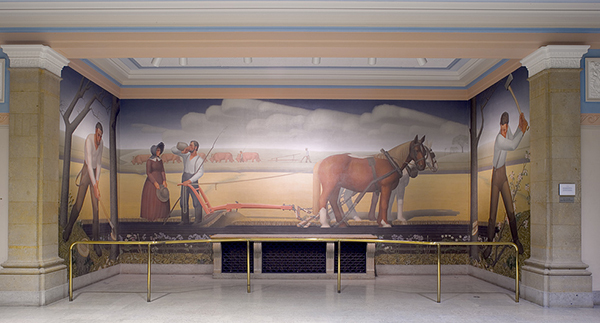
"Breaking the Prairie Sod" (1937), by Grant Wood, location: Rotunda, Parks Library. Submitted image.
Audiences:
|
Visual arts and culture |
Music |
Honors |
Residence department |
|
Agricultural and biosystems engineering |
Botany |
Anthropology |
Textiles and clothing |
|
Apparel, events and hospitality management |
Horticulture |
English |
Natural resource ecology and management |
|
Materials sciences and engineering |
Journalism |
Army ROTC |
Animal science |
|
History |
Agronomy |
Agronomy Extension |
Physics and astronomy |
|
Statistics |
Center for Excellence in the Arts and Humanities |
University library |
College of Agriculture and Life Sciences |
|
College of Veterinary Medicine |
Ivy College of Business |
|
|
New event ahead of exams: Cy's Finals Frenzy
The division of student affairs is hosting the first Cy's Finals Frenzy April 28-30 to promote healthy study habits and personal wellness for students during prep week. Held in the Memorial Union (MU) and outside spaces around the building, it features study options, opportunities to play and lots of snacks. It's free for Iowa State students.
More than 100 staff and faculty volunteers are needed to support this new event and the division of student affairs. Most volunteer shifts are on Sunday, with a few Monday evening. Volunteer duties include monitoring wellness activities, passing out to-go crafts, assisting with a smash room, facilitating meal lines and more. Volunteer summaries and sign-up are online.
Cy's Finals Frenzy
Daily schedule
"We look forward to welcoming students to the Memorial Union to study, eat and have a little fun," said Toyia Younger, senior vice president for student affairs. "I am grateful to several areas within the division of student affairs for creating a new and engaging program for students."
Faculty and staff are asked to encourage students to attend the events at the Memorial Union. Many of the activities are on Sunday, April 28, but the three-day event includes:
- Spaces reserved for both quiet study and group work, and open late
-
The Academic Success Center will offer:
- Supplemental Instruction leaders facilitating exam reviews and drop-in sessions
- Writing consultants to assist with projects
- Academic coaching: 1:1 walk-ins for test prep, time management and more
- Free meals: Sunday lunch, Sunday and Monday late-night breakfast
- Free snacks throughout the three days
- To-go crafts from the Workspace
- Wellness rooms hosted by student wellness
- Sunday evening movie on central campus
- Fun activities including smash room, tango class, yoga, karaoke, and bowling and pool at CyBowl and Billiards
- Outdoor lawn games hosted by recreation services
- Daily prizes and giveaways
"This is the first event of its kind at Iowa State and in the Memorial Union," said Michael Harwood, associate vice president for campus life and director of the residence department. "The MU is a great one-stop hub for students at any point of the year, but especially during prep week. We hope they'll take advantage of all the study space and free activities to help them feel their best and perform well on final exams."
ISU Dining launches pop-up bakeries this week

ISU Dining is hosting three pop-up events for its bakery products this week. Submitted image.
ISU Dining is showcasing one of its "sweetest" venues this week, Wednesday-Friday. The ISU Bakery will host three pop-up events that feature made-from-scratch specialty items normally not found in the bakery cases across campus -- and packaged for sharing with friends, coworkers and family. The specialty items will be available when each location opens until that day's supply is gone.
"We hear frequently, 'I didn't know ISU had a bakery.' This is a way we can get our name out there and showcase what we do," said Ben Billings, manager of the ISU Bakery. "We're hoping this is the first of many."
The pop-up locations and start times are:
- April 10, 7:30 a.m., the Hub, central campus
- April 11, 8:30 a.m., West Side Market, Union Drive Community Center
- April 12, 7:30 a.m., MU Market, Memorial Union across from the bookstore
Chef de cuisine Ed Astrita, baker Matt Behm and Billings selected the menu, which features seven items available each day:
- Pecan rolls
- Cinnamon roll knots
- Raspberry kolaches
- Cheddar bacon chive scones
- Spring-decorated sugar cookies
- Tea cookies in three flavors: mocha, chocolate shortbread, pecan
- Spring-decorated cupcakes
The items will be packaged in boxes of four or six. Quantities are limited, and a sampling table will be available so you can "try before you buy." The preferred payment is credit/debit cards or Dining Dollars (ISU Dining is a cashless operation).
Billings said he recommends trying the cheddar bacon chive scone. "There's no shortage of bacon, cheddar or chives in this scone," he said.
